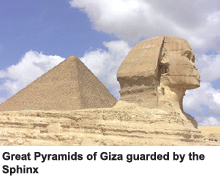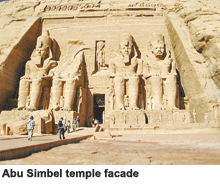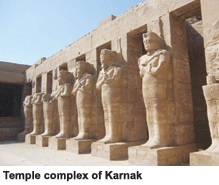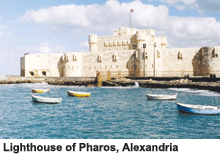The Lucerne (Switzerland)-based EF Educational Tours (EFET) — one of the 14 subsidiaries of EF Education First (estb. 1965 in Sweden), has more than 45 years of experience organising international educational tours for students and teachers, which it manages from offices in 50 countries around the world. In 2006, EFET established its India office in New Delhi.
“We believe that travel is a mind-broadening and educational experi-ence. To this end we organise afford-able, streamlined, educational tours for batches of school and college students to over 23 countries with the emphasis on cultural and historical content. Thus far we have sent over 150 student groups to 12 countries for educational tours of eight-ten days duration,” says Satya Divi, the Delhi-based managing director of EF Educational Tours Pvt. Ltd.
One of the favourite destinations of teacher-student groups from India is Egypt (pop. 77.4 million), where deciding where to go and how to round up its multiple wonders can be daunting. EducationWorld persuaded Hisham Fetouh, an Egyptology graduate of Cairo’s Helwan University and currently director (Egypt) of EF Educational Tours, to simulate a typical six-day student tour of this India-friendly country.
 There is something in Egypt for everybody. Its wonders are wrapped in legend — mummies, pharaohs, river Nile, the great pyramids, the Sphinx — all of them contributing to the mysterious allure of Egypt. Hieroglyphics look beautiful but are impossible to decipher; paintings are appealing yet hide more than they reveal. Even the giant stones of the pyramids have their own story to tell. Thus it’s no surprise that everywhere around the world, movies, plays and books are made and written about this enigmatic land of pharaohs.
There is something in Egypt for everybody. Its wonders are wrapped in legend — mummies, pharaohs, river Nile, the great pyramids, the Sphinx — all of them contributing to the mysterious allure of Egypt. Hieroglyphics look beautiful but are impossible to decipher; paintings are appealing yet hide more than they reveal. Even the giant stones of the pyramids have their own story to tell. Thus it’s no surprise that everywhere around the world, movies, plays and books are made and written about this enigmatic land of pharaohs.
Kemet, signifying black land, as Egypt was referred to during the Old Kingdom, came a long way from the 10th millennium B.C hunter-gatherer civilisa-tion to transform into the great Egyptian civilisation of 3,300 B.C-30 B.C. A visit to Egypt makes this ancient civilisation come alive. Because here history is not in books; rather, it unfolds before the viewer in an infinity of archaeological and cultural sites, worthy of personal visitation and exploration.
Day 1 — Cairo
We usually begin our first day in Egypt’s exciting capital with a local breakfast of ful mudammas (fava bean dip) with pita bread and eggs. Everyone is advised to eat well to pump up their energy levels for exploring the city of Cairo (pop. 17 million), known to its residents as Misr.
Cairo or Al-Qahirah which means ‘the victorious’ or ‘the triumphant’ is the largest and most populous city in Africa and the Islamic world. With more than a thousand years of history, it contains some of the most valued treasures of the ancient world. Just an hour away are the Great Pyramids of Giza; the world’s first stone building in Sakkara (2,700 B.C) and Memphis, the first capital city of the world. Infused with history, Cairo is so full of attractions that it can be an individual tour in itself.
But our first day is dedicated to the Museum of Egyptian Antiquities, commonly known as the Egyptian Museum, where the world’s most extensive collection of antiquities are on display — over 120,000 items offering insights into one of the most read and written about civilisations in human history. Among the treasures, the magnificent collection of the boy king Tut-Ankh-Amon, housed in three rooms including a special room for the Tut Golden treasury, hogs the limelight. The museum offers everything to everyone looking for any era of Egyptian history.
Day 2 — Cairo
Our second day in Cairo is reserved for an excursion to the Great Pyramids of Giza. Although I am a frequent visitor and guide, it never ceases to amaze me that the massive Pyramid of Cheops is a composition of 2,000,000 blocks of massive stone. In fact the great French general and emperor Napoleon Bonaparte, who invaded Egypt and took Cairo in 1798, estimated that the stone blocks of the three pyramids of Giza would have been sufficient to build a three metre high wall around the whole of France!
Just 300 m away from the pyramids is the ultimate icon of ancient Egypt, the Great Sphynx, rising like an apparition, 20 m (66 ft) in height with a 74 m (241 ft) long body — a perplexing half-lion, half-human effigy in stone, built during the reign of pharaoh Khafra (2,558-2,532 B.C). The magical day is rounded off with a sound and light (son et lumiere) show, which answers questions relating to the history and mystery of the Sphinx and Pyramids of Giza.
Day 3-6 — Nile cruise
 Herodotus, the great Greek historian (484 B.C-425 B.C) remarked that Egypt is the gift of the Nile. However, we Egyptians insist that the Nile was the gift of Egyptians who understood and tamed the river to generate unprecedented wealth and prosperity. Nevertheless, respect for this great river of history — the world’s longest (6,670 km) which begins its journey from Burundi in central Africa and flows through Uganda, Ethiopia, Sudan, before it reaches Egypt — is deeply embedded in the Egyptian psyche. It was on the banks of the Nile as it flowed through Egypt before it reaches the Mediterranean Sea, that perhaps the world’s oldest civilisation was built.
Herodotus, the great Greek historian (484 B.C-425 B.C) remarked that Egypt is the gift of the Nile. However, we Egyptians insist that the Nile was the gift of Egyptians who understood and tamed the river to generate unprecedented wealth and prosperity. Nevertheless, respect for this great river of history — the world’s longest (6,670 km) which begins its journey from Burundi in central Africa and flows through Uganda, Ethiopia, Sudan, before it reaches Egypt — is deeply embedded in the Egyptian psyche. It was on the banks of the Nile as it flowed through Egypt before it reaches the Mediterranean Sea, that perhaps the world’s oldest civilisation was built.
Our excursion on the Nile begins in the city of Aswan aka Syene. It was a flourishing trading town of southern Egypt, the link between the two cultures of Egypt and black Africa or Nubia. In Aswan the Nile flows through the amber desert and granite rocks in its full majesty, embroidered by mint-green ribbons of farms on both banks even as the citizens of Aswan live their lives according to old customs and traditions. Aswan (pop 2.72 lakh) is the dwelling place of the River God Habi who granted the Nile to Egyptians. During the cruise we skirt the Aswan Dam, one of the world’s biggest, built with American collaboration and completed in 1970. Our next site is the unfinished Obelisk of Aswan — the largest of the 29 Egyptian obelisks — translocated around the world (Paris, Rome, London etc). If finished, this Obelisk would have been 42 m (137 ft) tall and would have weighed 1,200 tonnes. The real story behind the failed construction of this obelisk is not known but legend has it that it was to be a gift of Hat-Ship-Sut, the only female pharaoh of Egypt during the 18th dynasty New Kingdom, to her father, Amon, the god of Karnak and patron of all deities.
Exploring the antiquarian attractions along the Nile, we cruise to the southern tip of Egypt, to Abu Simbel, where Ramses II carved a gigantic temple to symbolise Egyptian domi-nation over Nubia (Sudan) and the southern borders of Egypt. Perhaps this initiative pleased the Gods and made Ramses II live on in the memory of every Egyptian and student of Egyptian history. In 1881 Ramses’ mummy was discovered in a cache of 40 mummies at the Deir el Bahari temple. Nearly a hundred years later, the mummy was flown to Paris for treatment under a passport listing its occupation as ‘deceased king’!
Day 4. While enjoying the sights and splendors of the Nile, we drop anchor in the two agricultural towns of Kom-Ombo and Edfu. Two beautiful temples reflect the past glory of these towns.
Kom-Ombo is sited on a hill rising above the surrounding plains, offering a spectacular view of the curve in the river and a large island in the centre of the Nile. This island may once have been a haven for crocodiles which were hunted by the local people and then venerated as divine! Kom-Ombo boasts a unique double temple of rival gods — Sobek, the crocodile god and Haroris, or Horus, the Elder. Ancient Egyptian philosophy tolerated such contradictions.
Located 60 km to the north of Aswan, Edfu was the centre of the cult of a triad of gods consisting of Horus of Behdet, Hathor, and their son Hor-Sama-Tawy. The famous legend of Isis and Osiris is represented on the walls of Edfu temple, graphically narrating the continuous battle between good and evil, and from this myth modern Egyptians derive a great many of their daily traditions and customs. Today the most important monument in the city of Edfu is the Temple of Horus, the falcon-headed god, considered one of the most beautiful and well-preserved temples of ancient Egypt. Hardly surprising, considering it was completed over 180 years!
 Day 5. From Edfu we sail to the fabled city of Luxor, the treasure trove of Egypt. Here the chains of hills on both banks of the Nile curve away, leaving huge plains on which ancient Egyptians built their awesome civilisation. The Nile splits Luxor into two parts: east and west or life and death. On the eastern bank lie huge complexes of temples and houses. The west bank is studded with tombs and graves of pharaohs, representing the afterlife.
Day 5. From Edfu we sail to the fabled city of Luxor, the treasure trove of Egypt. Here the chains of hills on both banks of the Nile curve away, leaving huge plains on which ancient Egyptians built their awesome civilisation. The Nile splits Luxor into two parts: east and west or life and death. On the eastern bank lie huge complexes of temples and houses. The west bank is studded with tombs and graves of pharaohs, representing the afterlife.
Luxor’s star attraction is the immense Temple Complex of Karnak on the east bank of the Nile. Built by successive pharaohs from 1,400 B.C, several other Egyptian kings like Ramses II, King Tut and the great Hor-M-Heb made their contributions to this byzantine complex. Yet, perhaps the most unique feature of Karnak is its cultural diversity. During the rule of the Coptic Christians a church was built within, and after the rise of Islam in Egypt a mosque was built on top of the temple, thus giving this altar a special place in the cultural history of Egypt.
Day 6. We usually reserve the final day of EF Educational Tours’ Nile cruise to visit the ancient city of Alexandria, ‘The Pearl of the Mediterranean’ (pop. 4 million). Founded by Alexander the Great, Alexandria’s Graeco-Roman heritage distinguishes it from the rest of Egypt. In 331 B.C, Alexander passed through this one-time small fishing village named Racotese, and fell in love with it. Under his imperial command, Dinocratus, a renowned Greek architect, transformed the village into Alexandria, which became one of the most famous cities of the world. In 285 B.C the great pharaoh Ptolemy Soter conceived the idea of erecting the city’s legendary Lighthouse of Pharos Island which would be lit by the sun and mirrors during the day, and illuminated by fire at night. He commanded the architect Sostratus to execute the project.
 Completed by the great architect in 270 B.C using a massive labour force, the tower rose magnificently to a height of 384 ft, equivalent to a 40-storey modern building, making it one of the tallest structures on earth of the time. Encased in fine white marble, the beacon’s summit was topped with a magnificent statue, most likely of Poseidon, lord of the seas. The mirror of the lighthouse, made of polished bronze, was said to have reflected light more than 35 miles offshore.
Completed by the great architect in 270 B.C using a massive labour force, the tower rose magnificently to a height of 384 ft, equivalent to a 40-storey modern building, making it one of the tallest structures on earth of the time. Encased in fine white marble, the beacon’s summit was topped with a magnificent statue, most likely of Poseidon, lord of the seas. The mirror of the lighthouse, made of polished bronze, was said to have reflected light more than 35 miles offshore.
Alexandria was also the theatre of the legendary love affair between Queen Cleopatra and the Roman general, Mark Antony, and was a centre of learning housing some of the world’s first great libraries including the Royal Library of Alexandria.
Alexandria being the last port of call on the Nile cruise, we wrap up our six-day full and varied excursion to Egypt. The students come back, with memories of its awesome wonders, culture and history and always with an intention to return and continue their exploration of the myriad wonders of the world’s first great civilisation.